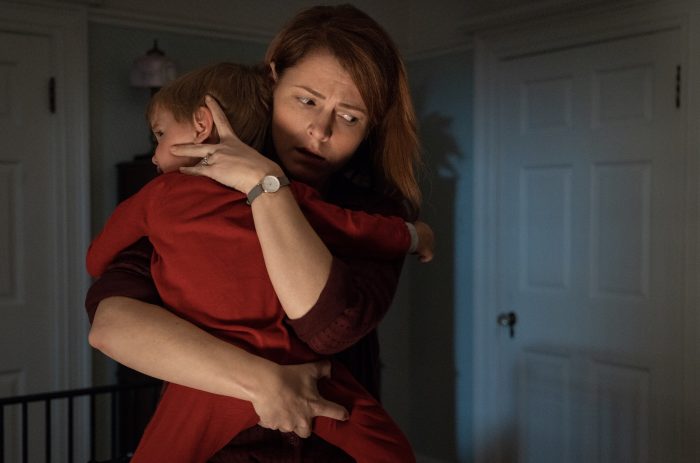'Pet Sematary': Bringing Stephen King's Most Terrifying Novel To Life [Set Visit Report]
Over the summer, I had the chance to head to the Montreal set of Pet Sematary, the new adaptation/remake of Stephen King's 1983 novel. What I saw there excited me beyond my wildest dreams. I'm a huge Stephen King fan, and Pet Sematary is my favorite King novel, immediately making me suspicious of any adaptation. What I came away with is the knowledge and confidence that the film is in excellent hands, and might just be the next great Stephen King movie adaptation.
(This Pet Sematary set visit report is as spoiler-free as possible. Check back with us closer to the film's release for a more spoiler-centric report.)
Sometimes, Dead Isn’t Better
We are in Ludlow, Maine. Before us stands a colonial-style house – a house that has seen better days. Its once fresh coat of white paint has chipped and peeled, like dead, dry skin flaking away from a husked corpse.The house is flanked by trees, woodlands as far as the eye can see, and, within all that greenery, insects whirr and chirp and cry. It's not quite dusk, but the darkness is on the horizon – waiting, watching. And so are we. We stand among dozens, maybe hundreds, of people who are frozen statue-still on the lawn, gazing up at the house. Everyone is dead silent. The only sound here is that of the insects. The air is thick and humid; discomfort has made itself at home here today.Suddenly, from somewhere buried within the peeling house, a scream echoes – a shriek from deep within the bowels of one's soul – harrowing and chilling and nerve-wracking. You can feel your blood run cold as the hair bristles on the back of your neck.And then a man casually strolls by carrying several tubes of fake blood. The spell is broken. Everyone begins to move and chat amiably.This isn't the fictional Ludlow, Maine, after all, but somewhere in Montreal. And these figures on the lawn are the mostly French-Canadian-speaking crew of Pet Sematary, Paramount's new adaptation of Stephen King's terrifying novel.Pet Sematary may not be King's most popular work, but it is the scariest. Just ask King himself – Pet Sematary is the one novel in the author's bibliography that actually scared him when he finished writing it. So much so that he tucked it away in a drawer, believing he'd gone too far and that it should never be published. Eventually it was published, of course, and became yet another best seller in a long line of best sellers.It also became a movie, in 1989, directed by Mary Lambert with a script by King himself. Rumblings of a possible remake/new adaptation of King's tome of terror attempted to crawl their way out of the grave for years. Even Guillermo del Toro showed interest. But nothing materialized. Cut to 2017: the new adaptation of King's It broke box office records, and Hollywood finally wised up to the fact that Stephen King adaptations were big business again.Now, Kevin Kölsch and Dennis Widmyer, the duo behind the indie horror flick Starry Eyes, are hard at work bringing a new take on King's story to the screen. With producers Lorenzo di Bonaventura and Mark Vahradian, they've assembled a killer cast.Jason Clarke (Dawn of the Planet of the Apes) is Dr. Louis Creed, who uproots his family – wife Rachel (Amy Seimetz, Upstream Color), daughter Ellie (Jeté Laurence), toddler Gage (twins Hugo Lavoie and Lucas Lavoie), and family cat Church (played by several talented felines) – to Ludlow, Maine. It should be a fresh start in an idyllic rural setting. Instead, Louis' new neighbor, Jud Crandall (John Lithgow), introduces him to a pet cemetery – crudely spelled as pet sematary by local children – nestled deep in the woods behind Louis' house. But that's not the only burial ground hidden in that forest. There's another patch of ground – the Micmac burial ground – located even further in...and it has its own dark secrets.We've been brought by van to the Pet Sematary set, tucked away on a rural road about an hour outside of Montreal proper. The road looks like any other stretch of country road, and could easily double as Maine. Houses sprout up here and there like weeds, and the residents are blissfully unaware that a few miles away from their front door, untold horrors are being constructed piece by piece.My number one goal is to catch a glimpse of the sematary itself, and I feel a bit like a child waiting for Christmas morning, anxious for that moment to come. I'm promised – or reassured might be the more accurate word – that I and the other journalists on the set visit will be brought to the sematary in good time. First, though, we drive past a huge tanker truck pulled off to one side, the word ORINCO painted carefully on the side. I catch my breath – anyone familiar with King's novel, as I obsessively am, will recognize that as the name of the trucking company that figures significantly in the story. Seeing this here makes Pet Sematary a reality. It's really happening. Stephen King's scariest book is coming back from the dead.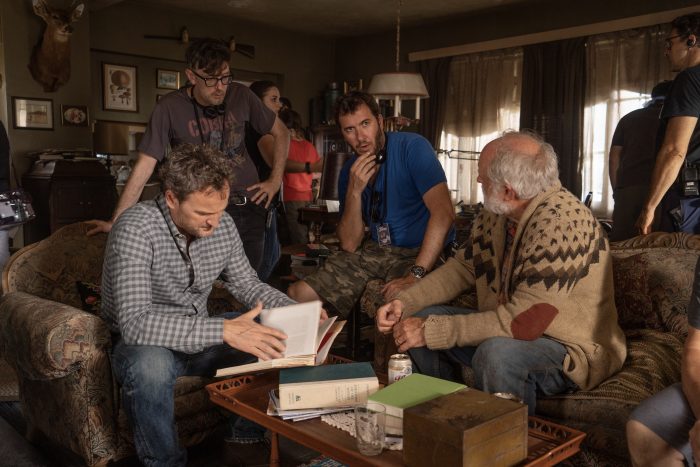
You Bring The Horror In With You
While the crew bustles about setting up a complicated scene involving Jason Clarke and John Lithgow, directors Kevin Kölsch and Dennis Widmyer emerge from that peeling, run-down house and meet us in the yard. Both men look a bit exhausted, and yet come alive when speaking about the film. Widmyer is the more talkative of the two by far, rattling off info about the production while a cigarette burns in his hand. Kölsch sits by his side with a thoughtful look on his face, waiting to interject."We're lucky that It did as well as it did, because now we're in another Stephen King renaissance and we shouldn't blow it," Widmyer says. "We should be making great movies out of this material, because the material warrants it. [Pet Sematary] is a very seminal book, it's very different from [King's] other books. [And] our approach to the material is very mature, very grounded, and we really understood the material."And what of that material? How true is this Pet Sematary hewing to King's novel, as opposed to the 1989 film adaptation?"There were a lot of things in the book that we were always big fans of or things that didn't even make it into the original movie that we wanted to do," Kölsch says. "And we worked hard to get those into the script. That has been our approach, to be faithful to the book. But the best remakes are the things that stay faithful to the essence, not necessarily every single thing that happens. We're making some changes, or doing some decisions based on the kind of things that we think would be really cool, but it's all within the essence and the spirit of the original source material."This is incredibly promising to hear. Based on the footage we see being shot today, it's clear that this Pet Sematary has nailed down the ever-present dread of King's novel. It's also found clever ways to remain faithful to King's prose while also interjecting new, exciting bits, resulting in something that seems fresh and alive. Earlier in the day, on a conference call with with Lorenzo di Bonaventura, the Pet Sematary producer elaborates a bit on some of the material changes in this new adaptation."I would say this: we are extremely faithful to it, both in literal content and especially, in addition, in emotional," di Bonaventura says, adding: "From the beginning we've tried to make the book very much our guiding light, both in literal content and in emotional content."But some changes were made, of course. "The one thing that I always struggled with in the book and in the movie that was made was Jud's reasoning behind telling Louis about the burial ground, or taking him to the burial ground," di Bonaventura says on the call.In King's novel, and the '89 film, the sudden death of the family cat inspires Jud to take Louis into the woods – to the pet sematary, and beyond. "It was an interesting process to go through the development of it because we kept trying to find a rational reason – this is why Jud would do it," di Bonaventura continues. "But what we ended up on, which I think is an incredibly satisfying result – which is an evolution, I'll say from the book – is that Jud is this lonely man who suddenly has a family that moves in who touches his heart. So it's an emotional decision he makes, not a rational decision."This is certainly a clever approach to Jud's motivation, and this sort of attention to detail has me excited. As does the fact that Kölsch and Widmyer understand that there's more to Stephen King that just horror. What makes King's work so immortal and universal is the way he creates his characters, making them seem fully formed. And the way he's able to tap into realistic themes and graft them onto a fantastical scenario."The supernatural element is a tool to tell [the] story," Widmyer tells us on set. "The same way The Shining is really about addiction because Stephen King was going through addiction at that time, and his use of the father and writer's block and claustrophobia and stuff. It's not about an evil hotel, you know? You bring the horror in with you, and that's really what this story is too. So we love that stuff."Widmyer adds later: "This is literary horror. This isn't just concept and shlock. This could be something more. I think we're excited to try to tell...an elevated, really smart, mature version."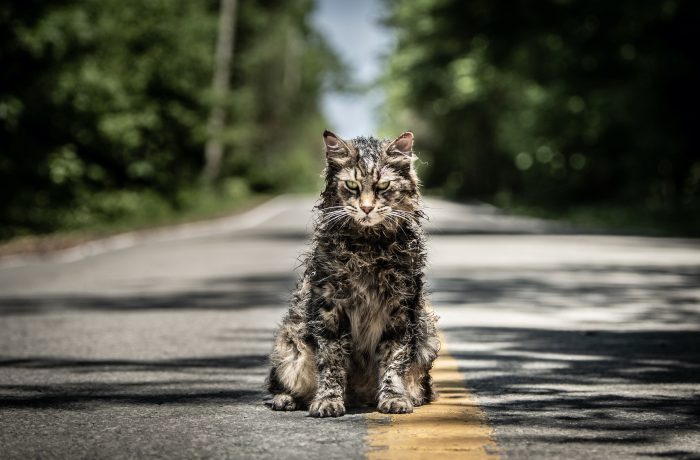
CGI Cats, Zelda and Stephen King Easter Eggs
Knowing that the filmmakers have a firm grasp on the down-to-earth dramatic elements of the film is great – but what about the supernatural? The unexplainable? The things that go bump in the night? One thing is for sure: the special effects bringing these things to life will be practical."It's as practical as we could get it," Widmyer says. "That was one of our first pitches – we had to go fully practical, you know?"So one can assume that probably means no CGI Church the cat, right?"No CGI cats," confirms Widmyer. "And it's a nightmare, I don't know why we said yes, but we're working with real cats...a trainer with like six different cats. And there's some days we wake up and we're like, what the hell were we thinking? You know, it's hard to get a cat to act. But a CGI cat would look like crap."One of the most terrifying elements of the 1989 film – the thing that still has the power to give audiences the creeps – is Zelda, the dead sister of Rachel Creed, who haunts her to this day. Andrew Hubatsek played Zelda in the '89 film, and the ghoulish makeup used on the actor was suitably horrifying.But it wasn't exactly true to King's work. For one thing, Hubatsek was clearly an adult, and the Zelda in King's novel is a child when she dies. And that's the approach the 2019 film is taking, going so far as to cast 13-year-old actress Alyssa Brooke Levine in the part. At first this might seem too much of a departure from the 1989 film to work, but the way the filmmakers explain things make it sound even more unsettling."[Zelda is] an 11- or 10-year-old girl with a debilitating disease in bed," Widmyer says. "So if you look at the psychology of the Zelda situation – it's a family that was dealing with a horrible situation that had a daughter that they couldn't fix, that was wasting away up in their bedroom, and they had a younger daughter [Rachel] who was in charge of basically like going in and taking care of her and being there as she disintegrated. That in itself is pretty horrific."Widmyer also points out that Zelda wasn't in the new film's script until they joined the project, and that they both wanted the character, and felt an urge to make her even scarier. "We came along and said you have to have Zelda. And then we just sort of accepted the challenge and said we gotta try to do something on our own and do something that honors the book but is our own thing, which is just as scary if not scarier than they did in the first one."A Pet Sematary movie without Zelda would be utterly strange, so we can all be thankful the character has made it into the film. And what else has made it into the film along with her? With the Stephen King renaissance in full bloom, can we expect to catch King-inspired Easter eggs peppered throughout the film, the way they were in the Hulu series Castle Rock?"The art department has had a blast on this one," Kölsch informs us. "They almost went too far, where they were showing us a sign that was like D. Torrance Realty [in reference to Danny Torrance, the kid from The Shining], and we're like, no. Because it can't be that. It's not like Danny Torrance went and opened up a realtor company in Ludlow, Maine.""They almost got too excited," Widmyer confirms, "where we were like, we're going to have Easter eggs, but they have to be accurate and they have to be organic. So we actually turned down a lot of Easter eggs, but we put in a lot of good ones that you're going to have to find...It's stuff that would be in the world. That's in the book. Smaller things that are happening in the background of our world or in the subtext of conversations.""Like, Carrie's not going to show up," Kölsch wryly adds.Soon, the filmmakers leave us, heading back inside that peeling house to prepare for the next scene. And we're needed elsewhere. Finally, we're informed, we're headed to the pet sematary.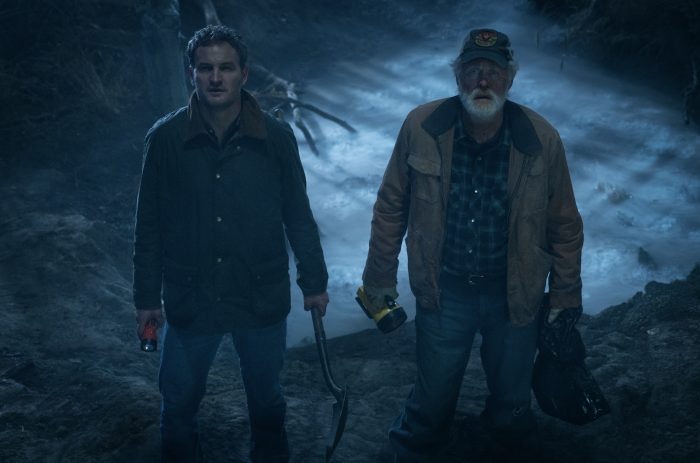
Jud and Louis
Except we're not. A slight miscommunication was made, and instead, we're bundled off to base camp – an endless sea of trailers and campers set up within a sprawling, barren field. We stroll across graveled earth, where we happen to catch sight of twins Hugo Lavoie and Lucas Lavoie, who both play Gage Creed in the film. The children run about, laughing, completely oblivious and indifferent to any horror lurking within the frames of Pet Sematary.We've come here to talk with John Lithgow, who takes on the role of Jud Crandall. Lithgow has been in the business for nearly 50 years, appearing in films such as All the Jazz, Blow Out, Interstellar, and yes, Shrek. And that only scratches the surface. Being in his presence is slightly surreal – he's imposingly tall, and having seen him for so many years on the screen it's a bit jarring to then catch sight of him in person.Decked out in a plaid shirt and dirty overalls, he greets us kindly inside one of the trailers. He's soft spoken, his words are perfectly enunciated. A warmth radiates from him. He's grown a heavy beard for the role, and in a nice added touch, the makeup department has stained the mouth area of his beard yellow with nicotine. Just as in King's novel, Lithgow's Jud is a heavy smoker.Lithgow inherits the part of Jud from the late Fred Gwynne, who turned in a highly memorable performance as the elderly neighbor, and really nailed the character's thick Maine accent so prevalent in King's book. But don't expect Lithgow to do the same."We all talked about [the accent]," Lithgow tells us, "and we even tried it different ways. I did a whole reading with a Maine accent. I personally felt that even people who are from Maine, even actors who get it absolutely right – an accent like that kind of takes you out of the story. I myself think that, especially how they have reimagined this script, which is changed from the book, to the first film, to this – it has evolved and Jud has become a more serious character, in a sense. He is a character in the pull of a kind of deep, deep regret, deep guilt, great longing, great feelings of loss, love. And because of that, I just felt he had to be a very genuine person. Listen, I have Boston roots. My father was born there, all my uncles and aunts were from there, I went to Harvard and I know Boston well. I can do an accent. But as soon as I start, that's all you're listening to."This genuine approach to the character falls in line with what Widmyer and Kölsch told us about their grounded, mature handling of the material. And Lithgow's take on the part of Jud is refreshingly serious – this is no frivolous role for him. He's inhabiting the character."The first you see of Jud – he's a gruff and forbidding, almost scary character," Lithgow says. "You don't know who this character's going to be – but his first scene is with a 9-year-old little girl [Ellie Creed], who is a very unusual 9-year-old girl, but she really warms to this character and he warms to her. And suddenly, you see this kind of forbidding guy, who for some reason can enchant a child. He just, he can really connect with a child – mean really connect, talk to her about death, talk to her about what it's like to be a little girl moving to a new town. He's like Mr. Rogers. He's got a strain of Mr. Rogers in him – the last thing you expect from this character. And that's the first you see of him – and before you see his demons. I just love the fact that all those things are going on with him.""You know, when you make a horror film," Lithgow continues, "the emotions have to be so authentic and everything that happens in the story has to really come out in various deep emotional needs from the characters. And that's built in to the way [Widmyer and Kölsch] have reimagined this story. You believe these feelings and you identify strongly with these characters and their needs, their longings, their feelings of love and anger, you know, and regret. You know, you'll find this quite a serious film when the time comes."Later – much later – Jason Clarke, who plays Louis Creed, will tell us something similar in this very same trailer. Clarke has been filming all day, and is covered in dirt from a scene he just shot. He's tired, and still has more to shoot. But he takes time when asked questions, ruminating on them for a long time before he gives us answers. "The thing in the book I love is that Louis has such internal monologue," the Australian actor says. "There's a sarcasm to him, and a wit to him, an irony, an awareness and a lack of an awareness. [Pet Sematary is] a story about a family and what you'd do, you know, if you could...[the burial ground is] just sitting up there, it's a hard itch not to scratch, you know, but then when you start scratching it, it gets pretty ugly. You know, it's not – it's a festering scratch, if that makes sense."Our talk with John Lithgow ends when the actor is called back to set. And at long last, we're told we're going to travel to the pet sematary.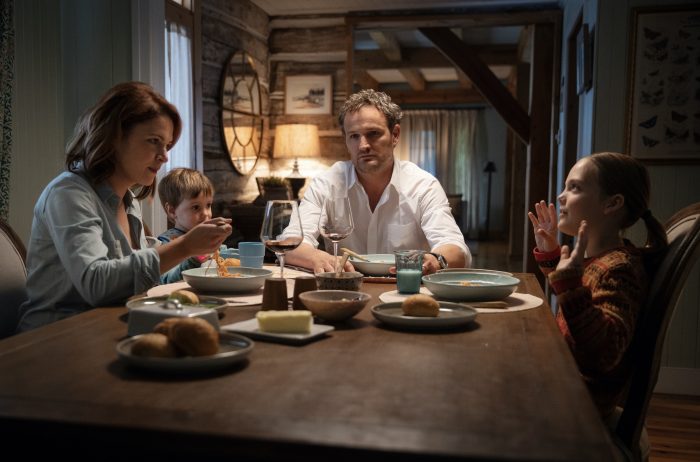
A Perversion Of Nature
Nope, never mind. We're not going there yet after all. Another miscommunication. Instead, we head back to the yard of the peeling, crumbling home, where we're given the opportunity to watch a scene being shot via a set of TV monitors. A scene I can tell you virtually nothing about, so as not to give away spoilers. I will tell you this: it looks visually striking, which immediately distances it from the '89 film. Mary Lambert's adaptation holds a place in my heart, but it hasn't aged particularly well, especially in the rather bland way it's been shot. There's nothing bland looking about the new Pet Sematary.While we watch the scene, we also chat with producer Mark Vahradian. Like the directors, and like Mr. Lithgow, Vahradian stresses the serious approach to King's book. "It's actually a family drama," Vahradian says of the film. "There's a lot of interesting thematics in it...there's this notion of nature and the power of nature and a family that moves from the city closer to nature, into the woods, and who is unfamiliar with that kind of savage power and doesn't really know the dangers of being outside of civilization. It's technically a horror movie, and it has scary stuff but that's generally at the back end of the story, and it's really about dealing with all these other issues and human choices and behaviors. So I think this is much deeper than most of the horror that's out there, and I think even most of the horror literature that's out there. And that was what was always so exciting for us."As the producer is talking, I catch sight of a crew member bringing a stuffed prop cat out and setting it up on a table. Sadly, we will see no live cats today (and thankfully no dead ones, either)."[This film deals with] a perversion of nature, which goes back to the natural themes," Vahradian continues, "and it was important to have...tender beats, where you can get the emotion of this story. And that's why I think this movie will have something that a lot of [other horror] movies don't – it really has a genuine emotional quotient, and it is heartbreaking, and a lot of times I question...are we being too sad? Is it too sad for a commercial horror movie? It's not always easy to convert a book to a screenplay, and in this case it took a lot of time to find the balance."And what helped with that balance? Finding the right directors."You know, these guys, [Kölsch and Widmyer], are huge King fans. They're super horror nerds. They're horror trivia fanatics. Ands they knew the book better than we knew the book, which was really the first thing, and they really had strong opinions about what we could use from the book, because we wanted somebody who actually knew what we were – if there were things we were missing that were going to be important, you know – yet we didn't want somebody who was too devoted, you know, to the point that they were going to demand everything from the book be in this movie, which you can never do in these things – obviously the book's too big, too vast. And so they were sort of a good balance."On the monitors, Jason Clarke is discussing the scene with Kölsch and Widmyer. No one can seem to decide where Clarke should put his hand within the frame of a shot, and several different variations are tried – the same scene repeated, again and again, until it looks exactly the way it should. We watch, somewhat transfixed, and the night is close to coming on. I'm ready to watch these monitors all night, but then, finally, the moment I've been waiting for since my plane touched down in Montreal is here. We're going to the pet sematary. For real this time.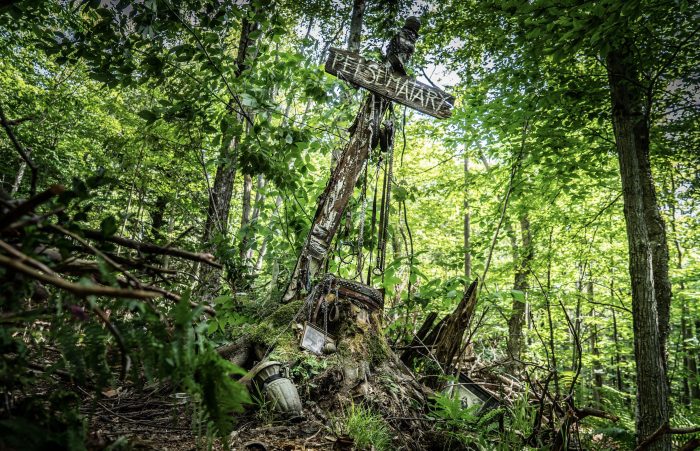
Pet Sematary
We're brought here via golf cart. First, we travel to the huge red farmhouse being used as the new home of the Creed family. Tall trees tower behind it, and a path has been made. The golf carts travel over the bumpy terrain of that path, deeper and deeper into the woods. Lights have been fixed up in the trees for night shooting. Dust kicks up from the earth. And before too long, we've arrived.To stroll into the pet sematary set close to dusk is something akin to a religious experience. Nestled deep in the woods, the childish graveyard – "Boot Hill for animals," Louis Creed calls it in the novel – is a marvel of production design.Nothing here looks fake or staged. In a concentric circle, homemade grave markers advertise the final resting place of (fictional) pets."BIFFER BIFFER A HELLUVA SNIFFER...""TRIXIE, KILT ON THE HIGHWAY"The inscriptions on these markers we see, and more, are taken verbatim from King's book.Wooden crosses, hammered together in lopsided angles; stones with diminished words chiseled into them; faded photographs of dogs and cats; religious iconography all around.The pet sematary entrance is marked by a totem so tall and emotionally devastating that it takes my breath away, and briefly makes me feel as if I might tear up. A wooden post – likely from a bed or a porch – juts from the ground at a crooked angle. A splintered piece of wood is hammered into the top of the post. PET SEMATARY is painted on that board in drippy, white letters. And wrapped around the post are hundreds upon hundreds of dog leashes and cat and dog collars. Studded, pink, black, faded, weathered. The remnants of countless pet lives, suddenly snuffed out one day. At the bottom of the sign rest water and food bowls. Off to the side is a framed painting of the Virgin Mary, nestled in some brush as if it had been tossed aside in a fit of rage.The insects hum; the air is still and hot. Death is comfortable here. And to stand here, right now, with the night coming in, is to be transported directly into King's novel. To find yourself in a real graveyard for dead animal. To feel the power of something ancient, and evil, pulsating through the woods.There's talk of rain tonight, and slowly, crew members begin shrouding the handmade tombstones in plastic sheeting, as carefully as a coroner encasing a corpse in a body bag. Silence takes over, as if we're in a real graveyard – as if to raise our voices here in this place of death would be disrespectful.And all around the sematary is what King calls the deadfall in his novel. Thousands of jagged, huge branches and tree trunks, piled up in a mad shape. An impossible, towering wall of stick and birch and bark. It looms large, and it feels like it's watching you. In the center of the deadfall is a hole – a spot for a camera to be placed, to peer out. But as you stand in the pet sematary, and peer into that hole, you feel the life running out of you. You feel darkness creeping in. You feel like something is watching you.In the film, as in the story, the deadfall leads to the Micmac Burial Ground. The place that has the power to bring back to the dead. The place where the ground has gone sour.The Micmac Burial Ground is being built on a soundstage, we're told. But looking up at the deadfall here, you can believe the real Micmac Burial Ground is just beyond. All you have to do to find it is climb over...and take a little walk.Pet Sematary opens on April 5, 2019.

